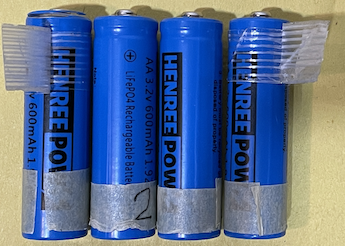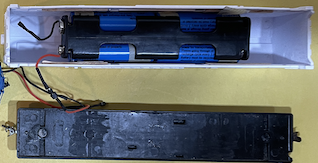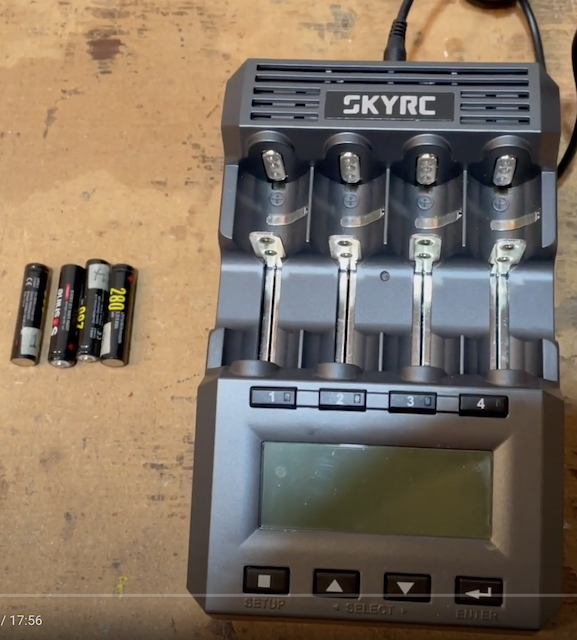On February 8, 2024, a four pack of Henreepow 3.2v AA 600mAh Rechargeable Battery, LiFePo4 Double A Rechargeable batteries were ordered, from Amazon, along with a 2-Pack 4 x AA Battery Holders. As of July 2025 the 4 pack was not available on Amazon, but a 2 pack and 6 pack was. They arrived, from Amazon, about 3 p.m. on 02/09/2024. Right out of the packaging for the four batteries, the weights were; 18.75g, 18.75g, 18.35g and 18.70g.  Masking tape was placed on them to number them, to later be able to identify each battery, and then the voltage read with a Fluke multimeter.
 All four batteries were placed in one of the 4 AA battery battery box holders and the voltage, using a Fluke multi-meter, was 13.17V. 
Original Boxcar Trial Fit
I noted that the battery box, with the 4 batteries, fitted into both the 53' gondola and 50' boxcar trailing battery cars. 
Henreepow were fitted in the gondola in the same manner. This is a later photo with 3 Efest 14500 650mAh IMR batteries and a "Fake" AA connector battery. The batteries came with no data sheet to indicate the termination volts per battery, nor were the batteries marked with a termination voltage.  They were charged on my SkyRC MC3000 at 0.3A with a termination volt cut off set to 3.65V, but maybe it should have been 3.60V, but 5 hundredths too much probably doesn't matter. The initial charge mAh returned; #1 337mAh, #2 390mAh, #3 394mAh and #4 388mAh. I was worried about battery #1. It weighed less and had about 60mAh less returned to it than the others. The batteries were discharged at 0.25A on the MC3000 to 2.9V under load. mAh to 2.9V loaded; #1 570mAh, #2 587mAh, #3 599mAh and #4 582mAh The stated labeled, at 600mAh, seemed reasonable. Battery #1 still appeared to be somewhat problematic. About 10 to 15 minutes after the discharge to 2.9V per battery, the voltages shown on the MC3000 were: #1 3.07V, #2 3.04V, #3 3.05V and #4 3.06V Because of the time, about 9 p.m., when the discharge finished, the batteries were rested overnight.
The discharge graphs looked quite similar and the capacity, mAh removed, was close on all four batteries. Each battery's internal resistance, as calculated by the MC3000 charger as Bat.Res., was about the same. 02/10/24 Before charging at 0.30A, 1/2C, to 3.65V on the MC3000, the voltages read by the Fluke were; #1 3.118V, #2 3.093V, #3 3.115V and #4 3.112V.
Battery #1's charge graph was very different from the other 3. The returned mAh; #1 590, #2 615mAh, #3 623mAh, and #4 607mAh. It looks like these are pretty close to the labeled 600mAh. 570/590 = 96.6%, 587/615 = 95.4%, 599/623 = 96.1%, 582/607 = 95.9% It looks like the actual mAh discharged is about 96% of returned mAh. 2" leads were added to the 4 battery battery box and Micro-Mark connectors added to the leads. (1" leads would have been okay.) The freshly charged batteries were installed and the CSX EMD GP15-1 diesel was connected to the LocoFiTM App. 6 pieces of rolling stock were added behind the loco and battery car; both 50' boxcars, the GT and SP boxcars, the tank car and the CSX caboose and made one loop around the track at the LocoFiTM App's setting at the time. A new speed step table was setup in the App and named 13 for the CSX and its trailing battery car pulling the 6 pieces of rolling stock using the 14500 LiFe batteries. A 1 Step speed table was set up and showed 21.54 seconds and 76.42 mph. The Max speed was set to 65 mph in the App. I ran the train prototypically for 28 minutes before doing a recharge. The batteries were rested for 1/2 an hour and recharged at 0.30A to 3.65V for an average amp draw test. To estimate the running time before actually running batteries, the following formula was used; 80% of the label's 600mAh is 0.480Ah divided by 0.25A (guesstimate of the average proto typical amp draw at the time) = 1.92 hours or 115.2 minutes. 115 min. / 4 runs = 28.8 minutes each Four prototypical runs, for 28 minutes each, were performed for a total of 112 minutes or 1.87 hours. The batteries were recharged at 0.30A to 3.65V using the MC3000. The mAh returned was; #1 416mAh, #2 423mAh, #3 422mAh and #4 417mAh. 0.423 Ah / 1.87 hr. = 0.23A (average amp draw)
More than likely, a full two hours is possible, which was later proven to be true. Next the Conrail, with boxcar battery car was set up. I used the same procedure as the CSX. The 1 Step time was 22.82 seconds and speed 72.13 mph. The Maximum speed was set to 65 mph in the App. The train was run about 28 minutes to run the battery down for charging tomorrow. 02/11/2024 The batteries were charged. The train was run prototypically for 2 hours using 30 minute sessions with periods of rest in-between. After the last session, the batteries were rested before recharging to determine the returned mAh figure. Returned mAh; #1 448mAh, #2 455mAh, #3 454mAh, #4 449mAh
That is the same as the previous averages. A second set of Henreepow 3.2v AA 600mAh Rechargeable Battery, LiFePo4 Double A Rechargeable batteries were ordered, to check the consistency, on 02/11/2024. As of July 2025, the 4 pack is no longer available at Amazon, but a 2 pack and 6 pack is. They arrived at 3:00 P.M. the following day. Data was collected to determine the weight of the 50' boxcar with the 4 AA size LiFe batteries.
The four new Henreepow battery's data was collected after numbering the batteries.
02/12/2024 The new batch of batteries were put on charge at 0.30A to 3.65V on MC3000 for initial charge. The initial charge mAh returned; #5 381mAh, #6 353mAh, #7 356mAh and #8 383mAh. They were allowed to rest for about 1 hour. The new batteries were discharged at 0.25A to 2.9V. The captured graphs are from the MC3000 App on my iPhone. Slot 1 is battery #5, Slot 2 is battery #6, Slot 3 is battery #7 and Slot 4 is battery #8.
During the discharge I noticed that battery #6 had an IR of more that two times the other three batteries. Discharge mAh; #5 573mAh,#6 581mAh, #7 589mAh and #8 577mAh. The battery #6 graphed a very odd discharge with a "bump" in it and the voltage didn't remain as high as the others. After the discharge, the batteries were not charged until the next morning. 02/13/2024 Before the charge, the resting voltages were; #5 3.14V, #6 3.13V, #7 3.14V and #8 3.12V on the MC 3000. The charge was set at 0.30A and the termination voltage was 3.65V.
During the charge, I noticed that battery 6 had a similar milliohm value to the other three batteries.
All four charge graphs looked about the same. Output versus Input mAh
Battery #1, from the first group, and Battery #6, from the second group seemed quite a bit different from the other batteries. They were retested with another discharge. Battery #1 was top charged (it was previously fully charge days ago) and rested along with battery #6, which had just been charged. Both batteries were discharged to check whether the noted anomalies were still present or whether running battery #1 for two full sessions and recharges and cycling battery #6 had returned them to a more typical state.
It looks like they are performing as expected at this time. Both of them had significantly lower IR values in this test when compared to earlier values. Batteries #1 and #6 were recharged and their returned mAh noted. Returned mAh; #1 593mAh and #6 604mAh
These are all looking very good now. It appeared that a couple of cycles helped get these eight batteries into alignment with each other. I find these batteries acceptable for our use. These are now my preferred batteries for use with the GP15-1s and their trailing battery cars. Both sets of these batteries are now in regular use. |
